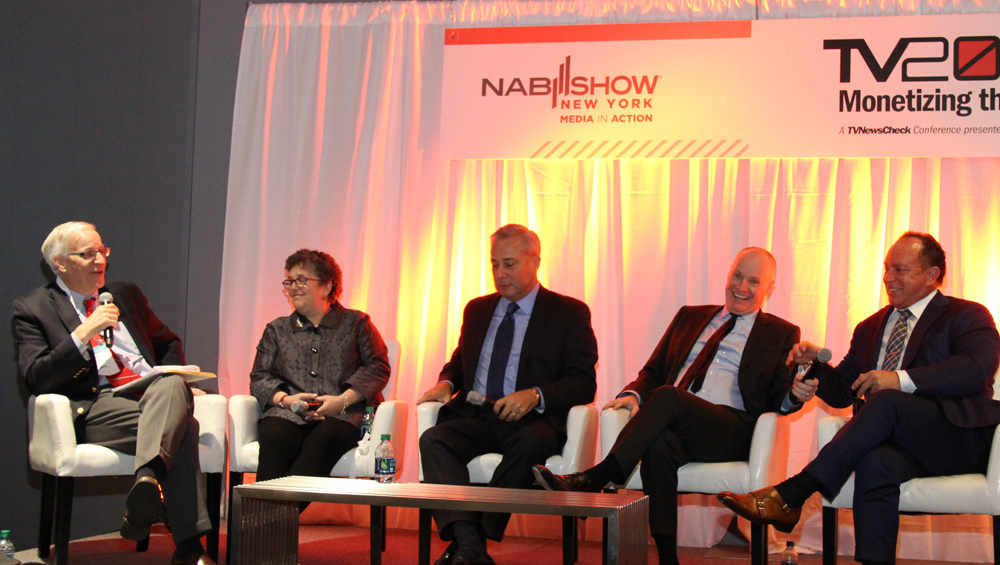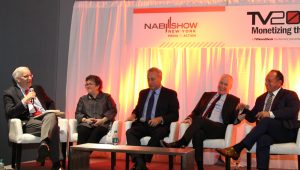
On Group CEOs Minds: FCC Cap, 3.0, Live Programming


L-r: TVNewsCheck’s Harry Jessell, Graham Media’s Emily Barr, Nexstar’s Perry Sook, Fox Television Stations’ Jack Abernethy and Gray’s Hilton Howell. (Photo: Wendy Moger-Bross)
Finding a way toward increasing the federal ownership cap on TV stations — and what that cap should be — was one of the key questions that a panel of CEOs focused on during TVNewsCheck’s TV2020 conference today.
“If you want this business to thrive, and be healthy in 10 to 20 years, you can’t defend a cap right now,” Jack Abernethy, CEO of Fox Television Stations.
What the FCC is grappling with in tackling the question, is what the cap should be that will be defensible in the courts and on Capitol Hill, should it be challenged.
Perry Sook, chairman, president and CEO of Nexstar Media Group, said he expects the FCC will make a ruling after the midterm elections this year or early next. “Maybe a way forward is to raise the cap to somewhere in the 60s or 70s [i.e., percentages] with the presumption that it goes away in three years. That may be a way forward, for the FCC to have a position that they can defend on the Hill, in the courts and with the industry.”
However, not all broadcasters believe that the cap should go away completely. Among them is Emily Barr, president-CEO of Graham Media Holdings, who chaired an NAB board subcommittee focused on the market cap issue.
“The problem is, 39% seems wrong and 100% seems wrong,” Barr said. “I think the thing about us that’s different, when you look at [broadcast TV] versus Google and Facebook, is that we are generating the content. They are just distributing it. If they want us to continue to deliver them content that they want to redistribute, they damn well better not try to kill us.”
Fox’s Abernethy pointed to the newspaper business’s woes as an indication of what can happen when caps aren’t lifted to support a rational business model. “It’s a dangerous game to restrict our ability to maximize the economics of this business.”
All the CEOs on the panel seemed to concur that the failed deal between Sinclair Broadcast Group and Tribune Media was an isolated incident and didn’t point to the likelihood of similar problems with the FCC vetting process in the future.
On separate but related front, the panelists were extremely bullish on how much live programming will play into the overall health of the broadcast industry — perhaps best exemplified by what’s known as New Fox, which Abernethy is part of, and which is focused heavily on live programming — not just sports and news. It could also extend to other genres, like game shows, he said, as long as it feels like it’s occurring in the present moment.
Barr noted that stations don’t need to rely on networks to give them the “steam” they need from live programming. Graham’s station in San Antonio is experimenting with an over-the-top platform offering local programming. “It’s remarkable how many people have found it,” she said. “To me, the future is local.”
“If you look at the 100 markets we’re in, the amount of local news we’re doing today is about 30% greater than the amount of local news those stations were doing at the time we acquired them,” said Nexstar’s Sook.
Sook noted a Nexstar experiment at KRON San Francisco: a subscription-based app that will roll out later this fall and transmit original local content. Nexstar plans on charging customers “a couple of bucks a month” and if 2% of the 110 million people reached sign up, “that’s a $80 million-$90 million business with no incremental costs, other than some technology.”
The CEO panel followed on the heels of a kumbaya moment for ATSC 3.0, as some two dozen broadcasters and consumer electronics companies announced their collective support of the standard. The CEO panelists explained that at this point, there is no need for a solid business 3.0 business plan to make sense of the massive initiative.
“This is a big asset that’s probably not going to be monetized until well into the future,” said Fox’s Abernethy. “That’s not a reason to slow down, or panic because we don’t know how to make money in ’19 or ‘20. Given the strength of the one-to-many technology, there has to be some big opportunities. Just because we haven’t identified them yet is in no way a bad thing.”
Hilton Howell, chairman, president and CEO of Gray Television, noted that his company is deploying 3.0 and 4K technology in every market it’s in. “When 3.0 is ready, Gray is ready,” he said. “Right now, the market has to catch up with the technology. But I think it’s happening very rapidly.”
In an earlier session on retransmission consent, Mark Fratrik, SVP and chief economist of BIA Advisory Services, estimated that retransmission consent net revenue is growing about 7% per year, on average, going out to 2023. But some of those on the CEO panel are actually more bullish regarding their own companies.
“I think your mileage will vary from entity to entity,” said Sook. “We forecast double-digit growth in our company, but not forever. Which is why we’re so bullish on spectrum opportunities. Because once retrans ceases to be a growth opportunity, I know my investors are going to say, ‘What now?’ ”
Read all of TVNewsCheck’s TV2020 coverage here.


































Comments (5)
HopeUMakeit says:
October 17, 2018 at 3:56 pm
Fox’s Abernethy pointed to the newspaper business’s woes as an indication of what can happen when caps aren’t lifted to support a rational business model. “It’s a dangerous game to restrict our ability to maximize the economics of this business.”
Wrong !
the only reason Newspapers died ( and possible democracy with it) is because newspaper bean counters stopped buying local TV spots to train future readers to seek out locally produced long form investigative journalism and reporting. This also explains how a draft dodging tax cheat could be in control of the launch codes as we speak.
RIDGELINETV says:
October 17, 2018 at 4:04 pm
Yep, combined with the fact that most people are just too dang lazy to read (and certainly too lazy to seek out the truth).
2018bstyrevr says:
October 17, 2018 at 7:09 pm
Its interesting they are putting a lot of stock in new technologies 3.0 and $K ( Big deal) because their advertisers are bailing and time sales are tanking!!..They are in trouble!!!
2018bstyrevr says:
October 17, 2018 at 7:10 pm
Poor Hopeumakeit..is he going to make it??
2018bstyrevr says:
October 18, 2018 at 8:10 am
Looks like the guy sitting all the way to the right’s head is about to explode..Go on a diet or get a shirt that fits…